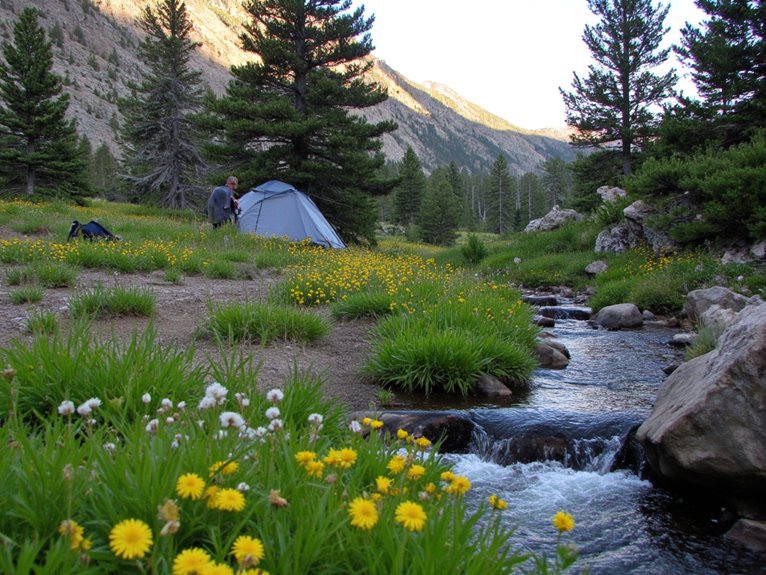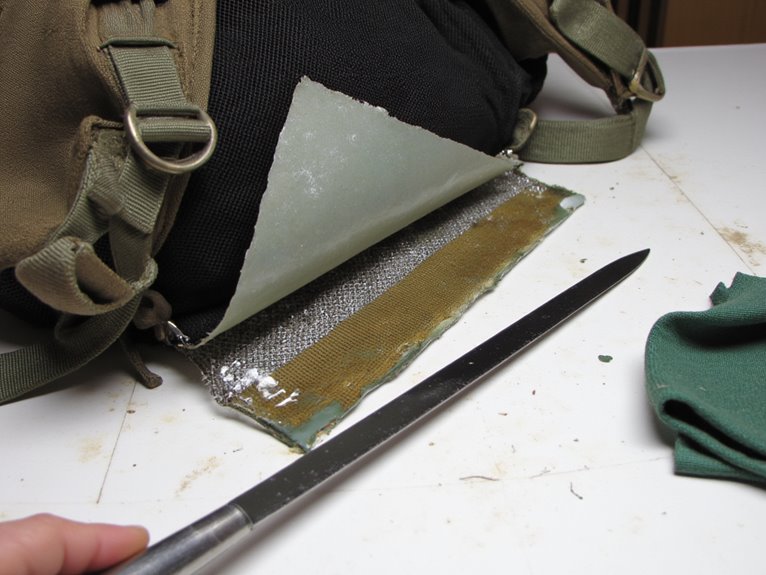Leave No Trace in High-Use Areas: Dispersed Camping and Waste
In high-use dispersed camping areas, you’ll need stricter waste protocols beyond standard Leave No Trace practices. Dig catholes 6-8 inches deep, positioned 200 feet from water sources, or use WAG bags when required. Designate specific trash collection areas using sealed bags to prevent wildlife conflicts. Strain greywater and scatter it 200 feet from water sources. Build fires only in existing rings, maintaining a 10-foot cleared perimeter. These elevated strategies become essential as overcrowding pushes ecosystems beyond their carrying capacity, and mastering these techniques opens doors to advanced conservation practices.
We are supported by our audience. When you purchase through links on our site, we may earn an affiliate commission, at no extra cost for you. Learn more. Last update on 18th December 2025 / Images from Amazon Product Advertising API.
Notable Insights
- Choose durable surfaces like rock, gravel, or established sites to minimize soil and vegetation damage in high-traffic areas.
- Dig catholes 6-8 inches deep positioned 200 feet from water sources, trails, and campsites for proper human waste disposal.
- Use sealed containers for all trash and pack out everything you bring, including food scraps and toilet paper.
- Strain greywater and scatter strained water 200 feet away from water sources, trails, and campsites to prevent contamination.
- Camp in previously impacted areas rather than creating new sites to concentrate impact and preserve pristine locations.
Understanding the Impact of Overcrowding on Natural Environments
When human populations exceed an area’s carrying capacity, natural environments face unprecedented pressures that fundamentally alter ecosystem dynamics. You’re witnessing overcrowding effects that directly fragment wildlife habitats, forcing species into smaller territories with limited resources.
Urban expansion has reduced original habitat to less than 1% for species like American bison. This habitat conversion disrupts ecological balance through increased human-wildlife conflicts and biodiversity decline.
Urban sprawl has decimated natural habitats, leaving critically endangered species with mere fragments of their ancestral territories.
You’ll observe that overcrowding accelerates deforestation, eliminating carbon sinks that absorb up to 48 pounds of CO₂ annually per mature tree.
The IUCN Red List documents over 45,300 threatened species, with 41% of amphibians facing extinction. Resource depletion intensifies as larger populations demand more food, water, and energy.
Pollution spikes correspondingly, degrading soil and water quality while ecosystem services like pollination deteriorate under mounting pressure.
Essential Waste Management Practices for Backcountry Camping
While dispersed camping offers unparalleled freedom to explore remote wilderness areas, it demands rigorous adherence to waste management protocols that protect fragile ecosystems from contamination.
Essential waste management begins with designating specific trash collection areas using sealed bags to prevent scattering. Never burn trash—pack everything out instead.
Human waste requires catholes dug 6-8 inches deep, positioned 200 feet from water sources. WAG bags provide alternatives when catholes aren’t permitted. Pack out all toilet paper, especially in arid regions.
Camp hygiene depends on proper greywater disposal: strain dishwater to remove food particles, then scatter strained water 200 feet from water sources. Use biodegradable soap sparingly away from streams.
Establish group protocols ensuring everyone understands proper disposal methods, keeping cathole shovels and hand sanitizer readily accessible.
Campfire Safety and Low-Impact Fire Techniques
Creating a responsibly managed campfire requires understanding both fire safety fundamentals and low-impact techniques that preserve wilderness areas for future generations.
Check local forest district websites for current fire restrictions before camping. These regulations change based on weather conditions and seasonal fire danger levels.
Build safe campfires at least 25 feet from tents, trees, and flammable materials. Use existing fire rings when available rather than creating new pits.
Clear a 10-foot perimeter around the fire site, removing leaves, twigs, and dry grass. Never build fires on moss or root layers that carry fire underground.
Keep water nearby for extinguishing. Let embers burn down completely, then douse with water and stir ashes until cold.
Never leave fires unattended, and always extinguish completely before sleeping or departing.
Strategic Planning for Sustainable Outdoor Recreation
Although recreational enjoyment often takes priority during trip planning, successful dispersed camping depends on strategic frameworks that balance visitor satisfaction with long-term ecosystem health.
Data-driven planning uses extensive asset databases and demographic mapping to identify recreation gaps. This approach guarantees equity access by targeting investments toward underserved populations within reasonable proximity to quality outdoor spaces.
Effective frameworks integrate social-ecological principles across multiple spatial scales. Planners monitor visitor patterns and ecosystem interactions to establish appropriate carrying capacities. Adaptive management strategies optimize both conservation outcomes and user experiences through continuous assessment.
Strategic investment in sustainable infrastructure addresses environmental degradation in high-use areas. Trail enhancements, waste management systems, and transportation improvements support long-term viability.
Collaboration between agencies, universities, and nonprofits leverages diverse expertise for thorough planning that serves ecological integrity and social equity equally.
Proper gear selection, including moisture-wicking hiking socks with antimicrobial properties, prevents common foot problems and reduces the environmental impact of extended outdoor stays.
Building Conservation Awareness Through Visitor Education
Education programs serve as the primary mechanism for transforming casual outdoor enthusiasts into informed stewards of dispersed camping areas. Wilderness education reduces physical resource impacts by 40% when combined with targeted messaging about waste disposal and campsite selection. You’ll achieve maximum visitor engagement through issue-specific brochures rather than broad pamphlets.
| Education Method | Effectiveness Rating |
|---|---|
| On-site backcountry education | High impact |
| Electronic communication channels | Wide reach |
| Visual aids (back-of-map info) | Moderate retention |
| Face-to-face interpreter programs | Highest engagement |
Multiple platforms enhance message delivery. Trained interpreters facilitate authentic, place-based experiences that increase learning retention by 65%. You should integrate scientific research messaging with recreational education to build thorough understanding of dispersed camping impacts on watershed protection and wildlife habitat. Bikepacking enthusiasts require specialized education about Leave No Trace principles since their lightweight gear setup can encourage more frequent dispersed camping in sensitive areas.
Frequently Asked Questions
What Specific Gear Should I Bring for Leave No Trace Camping?
You’ll need essential camping equipment including a multi-tool, navigation aids, and illumination gear.
Pack heavy-duty garbage bags and a portable trowel for proper waste disposal. Bring reusable containers, water purification systems, and biodegradable soap.
Use a camp stove instead of fires, plus waterproof shelter with ground protection.
Include durable clothing layers and sturdy footwear to minimize environmental impact while maintaining safety.
How Do Weather Conditions Affect Leave No Trace Practices?
Weather preparedness directly influences your Leave No Trace effectiveness.
Wet conditions require you to stay on durable surfaces and pack out all waste since rain spreads contamination.
Snow allows surface camping but demands specialized waste disposal techniques.
You’ll need impact assessment skills to choose appropriate campsites during storms.
Muddy trails force single-file hiking to prevent widening.
Proper gear preparation prevents weather-induced LNT violations.
Are Leave No Trace Principles Different for Winter Camping?
Yes, winter camping practices require significant adaptations to Leave No Trace principles.
You’ll camp on snow-covered surfaces instead of bare ground, protecting underlying vegetation. Snow shelter considerations include avoiding patchy coverage that exposes plants.
You must pack out all human waste since cold temperatures prevent decomposition.
Travel routes change to prioritize deep snow cover, and you’ll need enhanced planning for avalanche zones and severe weather safety considerations.
What Are the Legal Consequences of Violating Leave No Trace Guidelines?
Most Leave No Trace principles carry no legal implications since they’re voluntary guidelines, not federal laws.
You’ll face enforcement measures only for specific violations like littering or improper waste disposal. Penalties typically involve warnings or fines under $100.
You’re unlikely to encounter serious legal consequences unless you cause significant environmental damage or safety hazards.
Remote areas have minimal patrol presence, reducing enforcement probability considerably.
How Do I Find Designated Dispersed Camping Areas Near Me?
You’ll find designated dispersed camping areas by checking official forest service and BLM websites for current Motor Vehicle Use Maps.
Contact local ranger stations directly for real-time site availability and closures. Use FreeCampsites.net for GPS coordinates and user reviews.
Download agency mobile apps with mapping layers. Always verify local regulations before departing, as popular areas increasingly require designated sites only.
On a final note
Your commitment to Leave No Trace principles directly protects wilderness ecosystems for future generations. You’ve learned essential waste management protocols, low-impact fire techniques, and strategic planning methods. These skills reduce environmental degradation by up to 80% when properly implemented. You’re now equipped to minimize your footprint while maximizing outdoor experiences. Apply these evidence-based practices consistently. Your responsible actions preserve natural areas and maintain access rights for all outdoor enthusiasts.



